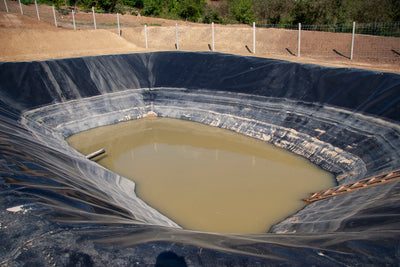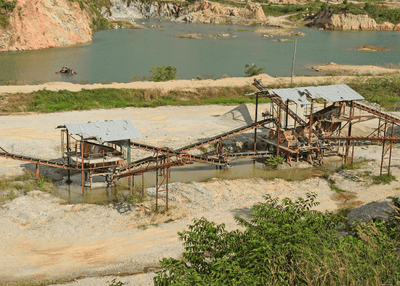Water Quality InformationWritten By Actual Experts
RSSDrinking Water Supplies Risk Contamination from Toxic Wastewater Ponds

Bioaccumulation & Biomagnification Of Toxic Chemicals: What You Need To Know
Editor's Note: We've been writing more articles about organic chemicals like endocrine disruptors, methylated mercury, so we've been getting a lot of questions about how people become exposed to these chemicals. Even though these questions deal more with food than drinking water, we though that it'd be worthwhile to spend some time on an article explaining how this happens.
What is Bioaccumulation?
Bioaccumulation refers to the process of toxic chemicals building up inside of an organism’s body. This happens when a chemical is consumed or absorbed, and the body cannot catabolize or excrete it quickly enough. Mercury is a well-known chemical that will bioaccumulate in humans. We commonly hear about mercury exposure resulting from eating fish such as tuna (or other large predatory fish). However, mercury as well as many other harmful chemicals can also be found in drinking water supplies across the United States.
Chemicals that tend to bioaccumulate are stored in cells and not exposed to direct physical or biochemical degradation. These chemicals can collect and hide-out, particularly within adipose tissue (fat cells). Fatty mammary tissue often contains the highest concentrations of toxic chemicals. These chemicals in our mammary tissue are then passed along to infants when nursing.
What is Biomagnification?
Biomagnification refers to the process of toxic chemicals increasing in concentration as they move throughout a food chain. Bioaccumulation and biomagnification often work hand-in-hand; one animal accumulates chemicals in the body (bioaccumulation) and then a larger predator consumes that smaller animal such that the chemical is passed along to the predator. The chemical “magnifies” as the resulting concentrations increase in the predator because it likely consumes large quantities of that particular prey throughout its lifetime (biomagnification). As top-level predators in our own food chain, humans tend to collect high concentrations of toxic chemicals in our bodies.
What are Persistent Bioaccumulative Toxics (PBTs)?
PBTs are a particular group of chemicals that threaten the health of humans and the environment. Examples include methylmercury, polychlorinated biphenyls (PCBs), dichloro-diphenyl-trichloroethane (DDT), and dioxins. PBTs are considered extremely dangerous to both humans and wildlife because they remain in the environment for a very long time without breaking down, then bioaccumulate and biomagnify in ecosystems (including ours).
PBTs can also travel long distances and move between air, water, and land. DDT, a notorious environmental pollutant, was developed as a synthetic insecticide in the 1940s. Sprayed over crops, DDT would then wash into water supplies and contaminate lakes, ponds, streams, rivers, and oceans. Small organisms such as plankton and algae absorb DDT through the water. Smaller fish then consume the contaminated algae and plankton. Larger predatory fish then consume the smaller fish. Eventually, large predatory birds or humans eat the contaminated fish. Despite being banned in the United States over 40 years ago, DDT is still found in soil and water supplies today. In addition, humans contain the highest concentrations of DDT when compared to other organisms.
How Does This Impact Human Health?
Exposure to PBTs has been linked to a wide range of toxic effects in humans and wildlife. Some of those adverse effects include but are not limited to disruption of the nervous and endocrine systems, reproductive and developmental problems, immune system suppression, and cancer.
How Can I Minimize Exposure To PBTs?
- Avoid eating species of fish that are long-lived and high on the food chain such as tuna, marlin, shark, swordfish, king mackerel, and tilefish.
- Use a high quality water filter that removes PBTs (e.g. DDT, Dioxins, BPA, Phthalates) from contaminated drinking water before the chemicals get a chance to accumulate in you.
More Articles We Think You'll Love:
Important Things To Know About Chromium 6 In Drinking WaterWhy Are So Many Schools Testing Positive For Lead?
5 Things To Know About Arsenic In Drinking Water
Mining Activities Can Contaminate Water For Years Afterward

Daphne Abrams M.S.Ed. | Scientific Contributor
I became interested in the impact of mining a few years ago when I started teaching an environmental science class in northwestern Nevada. Nevada has a rich history of pioneers and mining (It is the silver state after all). While mining can be a source of revenue and prosperity for an area, it also has a huge environmental impact that can last many decades after the mining activity ends. This article discusses how this has played out in the Carson River.
Historical Mining Activities And EPA Superfund Sites
EPA’s Superfund program is responsible for cleaning up highly contaminated land and responding to environmental emergencies, oil spills and natural disasters in order to minimize long-lasting contamination from these events. Even though the government has categorized these sites as highly toxic, they are sorely underfunded when it comes to cleanup and often forgotten about altogether. This is particularly problematic because one in five Americans live within 3 miles of a Superfund site. The closest two Superfund sites to the school that I teach at are two abandoned mining sites. One is the Carson River Mercury Site, which is the legacy of silver and gold mining in the area, and the other is from the abandoned Rio Tinto Copper Mine.
Lasting Impacts Of Historical Mining Activity On The Carson River
Between the contamination from these two Superfund sites, roughly eighty miles of the Carson River is paralyzed by heavy metal toxicity. Even though contamination likely occurred in the 1800s, there are still advisories not eat fish caught in that stretch of the Carson River, due to concerns about mercury, which biomagnifies up food the food chain.
What's Being Done About Contamination From Historical Mining Activities?
While it seems hard to debate against cleaning up these types of historical toxic messes, the Senate and House voted to overturn the “Stream Protection Rule” shortly after President Trump took office, as part of the new administration's campaign promise to relax environmental regulations.
Do You Have More Questions About How Does Mining Affect Water Today?
Hydroviv makes it our business to help you better understand your water. As always, feel free to take advantage of our “help no matter what” approach to technical support! Our water nerds will work to answer your questions, even if you have no intention of purchasing one of our water filters. Reach out by dropping us an email (hello@hydroviv.com) or through our live chat. You can also find us on Twitter or Facebook!
Recommended Articles For YouWhat Do I Need To Know About Mercury Contamination In Water?
Why Are Bioaccumulation And Biomagnification Important?
Where Can I Learn More About EPA Superfund Sites In My Area?
Will Water Filters From the Musk Foundation Remove Lead?
Analies Dyjak | Policy Nerd
October 4, 2018- Elon Musk and The Musk Foundation confirmed a donation of $480,350 to Flint, Michigan Community Schools in hopes of addressing lead contamination in drinking water. Flint is one of many school districts across the country that has been working hard to generate long-term solutions for lead contamination in drinking water. This article examines whether the proposed filtration technology will effectively remove lead from drinking water.
How Will The Funding Be Used?
Musk initially announced the filters would comply with FDA’s 5 parts per billion standard (which is actually the standard for lead in bottled water), instead of EPA’s 15 part per billion Action Level. While definitely lower than EPA's threshold, the American Academy of Pediatrics and Center for Disease Control have both acknowledged that there is no safe level of lead for children. The Musk Foundation has not released the exact type of water filters Flint, Michigan Community Schools plans to use. Press releases have indicated some type of ultraviolet filtration system.
What Is UV Water Filtration?
Ultraviolet filtration eliminates biological contamination from drinking water. This includes bacteria, viruses, and harmful microorganisms like E.coli. The idea behind UV filtration is it prevents microorganisms from reproducing, by striking each individual cell. It’s comparable to and often more effective than using chlorine to kill bacterial contamination.
Does UV Filtration Filter Lead?
No. While UV filters are great at removing biological contamination from drinking water, they have several limitations. UV filters by themselves are not able to remove chemical contaminants including Volatile Organic Compounds, chlorine, lead, mercury and other heavy metals. To remove chemical contaminants (including lead), a UV-based system would need to be paired with lead removal media or reverse osmosis.
Our Take
Contrary to a lot of media reports, UV filters do not remove lead from water, so we're hoping that the UV is paired with a system that removes lead. We also hope that the filters are installed at the point of use, because water treated by a point of entry filter can accumulate lead in any pipe "downstream" of the filtration unit.
Other Article We Think You Might Enjoy:Why Are So Many Schools Testing Positive For Lead In Drinking Water?
Volatile Organic Compounds: What You Need To Know
Lead In Drinking Water
Heavy Metal Toxicity and Contamination
Digging Into The Environmental Working Group Tap Water Database

Eric Roy, Ph.D. | Scientific Founder
This past week, the Environmental Working Group (EWG) released a website where people punch in their zip code, and view contaminants found in their water. As a company that uses water quality data to optimize each customer’s water filter, we applaud EWG for putting in the enormous amount of time & effort to build the database so the public can learn about their water. Unfortunately, we are seeing that these data are being used to generate inflammatory headlines, which can leave consumers confused and unnecessarily panicked.
We will be updating this water quality database blog post as more questions come in. If you have your own question, please reach out to us (hello@hydroviv.com). One of our water nerds will do their best to get back to you very quickly, even if it’s outside of our business hours.
Frequently Asked Questions
Updated July 31, 2017
Are All Potential Contaminants Listed In The EWG Tap Water Database?
No. The EWG Tap Water Database pulls data from municipal measurements, but municipalities are only required to test for certain things. Simply put, you can’t detect what you don’t look for. One example of this can be seen by punching in Zip Code 28402 (Wilmington, North Carolina) into the EWG Tap Water Database. GenX, a chemical that has been discharged into the Cape Fear River by Chemours since PFOA since 2010, is not listed, even though it’s been in the center of a huge topic of conversation for the past 2 months in the local media.
Why Is The “Health Guideline” Different Than The “Legal Limit?”
The two different thresholds use different criteria. For example, the “Health Guideline” cited by EWG for carcinogens is defined by the California Office of Environmental Health Hazard Assessment (OEHHA) as a one-in-a-million lifetime risk of cancer, while the “Legal Limit” refers to the MCL which is the limit that triggers a violation by EPA. The OEHHA's criteria are established by toxicological techniques, while the EPA limits are negotiated through political channels. We wrote an article that addresses this topic in much more detail for those who are interested.
Why Am I Just Learning About This Now?
The EPA's Safe Drinking Water Act requires municipalities to make water quality test data public in Consumer Confidence Reports. These reports are required to talk about the water's source, information about any regulated contaminants found in the water, health effects of any regulated contaminant found above the regulated limit, and a few other things. As discussed before, the data in the EWG report use different criteria than the EPA, and it's hard for people to make sense of what's what.
Are The Data Correct If My Water Comes From A Private Well?
No. The EWG Tap Water Database only has data for municipal tap water. Private wells are completely unregulated, and there's no requirement to conduct testing. If you'd like us to dig into our additional water quality databases to help you understand likely contaminants in your private well, we're happy to do so. We don't offer testing services, but we're happy to help you find an accredited lab in your area, give advice on which tests to run, and help you interpret the results! We offer this service for free.
What About My City's Water Quality?
Hydroviv makes it our business to help you better understand your water. As always, feel free to take advantage of our “help no matter what” approach to technical support! Our water nerds will work to answer your questions, even if you have no intention of purchasing one of our water filters. Reach out by dropping us an email (hello@hydroviv.com) or through our live chat. You can also find us on Twitter or Facebook!
Recommended For You
How Do I Filter Chromium 6 From Drinking Water?Why Are So Many Schools Testing Positive for Lead?
Please Stop Using Cheap TDS Meters To Evaluate Water Quality! They Don't Tell You Anything!




